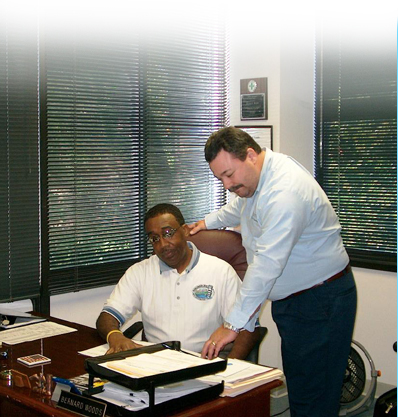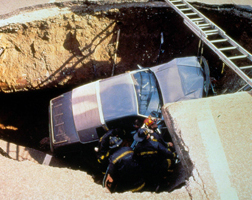

SOP Development Overview
SOP Development Overveiw
Among the issues most often overlooked by a utility, standard operating procedures (SOPs) are typically high on the list, or, are not actually SOPs in content. Personnel who are doing the same set of tasks repetitively, such as sewer line maintenance with a flushing machine or pump station inspection at set sites, typically have little need for a written document of the processes they use.

It is not until there is an accident that causes someone to look for these SOPs, or someone leaving/entering a utility they are looked for as a training tool.
Simply stated, SOPs are not how-to manuals. They are a guideline document with specifics of operation in them so a wide group of people can operate equipment or perform various tasks similarly, without hobbling them to a set procedure which may not work well for them. Many SOPs are actually how-to manuals, which lose sight of what their intent is and bog down in the minutia of the task or process to the point they lose value as a guideline document.
Tilson & Associates creates SOPs for most every facet of system operation and management, typically using the personnel assigned to those tasks to create the base document. Our process starts and ends with the people who perform the work being documented and should be of and with their input. Oversight of utility safety practices or policy issues are ensured with management and co-worker review of the material prior to issuance.
Maintenance Equipment
Of all the procedures in collection system operations, equipment deployment and use is probably the most widely interpreted issue in the utility. If there is more than one operator of this equipment, there likely will be more than one way the machine is used in specific circumstances, from set up through operation and job close out. This becomes an issue when there is equipment damage or SSO events in lines that were reportedly cleaned recently, causing the utility to look at how the operation procedure is done. Interviewing the field foreman or crew chief can deliver one mode of operation, subsequent interviews with other chiefs or operators can deliver a second or third and fourth.
It is very important for operators to have flexibility in this equipment operation an use, but also in following known or set procedures for the work as well. This is the art of the SOP when done properly. It provides a clear set of guidelines of operation that can be meandered in as needed, with clear out of bounds markers put into the document that helps reduce the opportunity for accidents, injury or property damage.
Tilson & Associates provides SOP development and documentation services on the equipment used in collection system operations, from managerial vehicle use and maintenance recording, to field equipment such as rodding or flushing machines, CCTV inspections, excavating equipment, and other equipment commonly used by the utility. These documents ensure the equipment is run in a consistent manner between operators, because they are designed and agreed to by those operators. Further, these documents can be used to monitor and correct field maintenance issues to the point that the service department for the vehicles and equipment are better able to track and address problems endemic to operations or the equipment itself.
Pump Stations
Pump stations are critical assets that require regular and routine inspections and cleaning. These are the backbone of any collection system and the most likely point of failure of the system unless specifics equipment is put on site, such as stand by generators. That said, one of the least considered areas of potential consequence are pump stations when they are running smoothly for a long period of time. Personnel who inspect these facilities are typically the same people on a daily or weekly basis and understand exactly what needs to be looked at, recorded, and cleaned or maintained on a routine basis. This makes pump station SOPs that much more important to construct, so that people unfamiliar with the station can perform routine inspections if the regular personnel are not available.
Tilson & Associates provides SOP development and documentation services on pump station inspection, maintenance, and emergency response (see also our section on ERP development under SSO Prevention). Using pump station personnel, we construct a step by step procedural guideline, allowing for full data capture of the station inspection, critical system monitoring, pump rotation and other aspects of routine inspections. Documentation is also made on routine cleaning and maintenance of the station using on-site visits to the station itself with the personnel.
The emergency response for each pump station is likely to be different, with each station having its own unique issues when the station stops working. Each will have a different discharge point of wastewater backing up in or from the station for example, some flooding the station itself or a manhole just outside of it, to the lowest manhole structure in the feeding sewer pipe that can be up to a half mile distant. This requires a specific response plan for each station, from the deployment of portable generators and how to hook them up to restore power, to by-pass pumping operations and how to engage this and isolate the station from service so pumps can be worked on.
Process and Procedural SOPs
Probably the last point of issue on SOPs is documentation of procedures used as a matter of routine. For example, notification of state regulatory agencies is typically well documented for people to follow, but when to call in additional help in after hours response, or how to properly document an injury, or laying out the duties of the receptionist may not be. These are considered more administrative or job description functions than SOPs, however, in the process of addressing all the processes and systems of the agency (see our cMOM section) these are important elements of the cMOM process that should be completed.
The most frequently claimed impediment to getting this done is time, with manpower being a close second. These can be very mundane and thankless projects in detailing of various processes or procedures used by people on a routine basis, however, they are needed at various times, for example when there is a turn over in a given position or when there is an emergency which may involve a process or procedure, even from the receptionist level.
Tilson & Associates helps provide the documentation and SOPs for these varied processes and procedures used in both field and management and can do so typically at a savings of time and money over the utility engaging the process themselves. We can develop SOPs for critical operation management, how media is handled during emergencies, processes for recording various inbound data for use in work order management, and other similar procedures. Though not considered to be a high priority by some utilities, its not until there is a loss of personnel that its discovered corporate memory has left with the person or worse, when an emergency occurs and critical steps are missed in the processes dealing with it.
